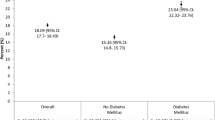ABSTRACT
BACKGROUND
In the United States, public health insurance is available for nearly all persons with end-stage renal disease (ESRD). Little is known about the extent of health insurance coverage for persons with non-dialysis dependent chronic kidney disease (CKD).
OBJECTIVE
To describe patterns of health insurance coverage for adults with non-dialysis dependent CKD and to examine risk factors for progression of CKD to ESRD and management of hypertension among those lacking insurance.
DESIGN AND PARTICIPANTS
Cross-sectional analysis of data from a nationally representative sample of 16,148 US adults aged 20 years or older who participated in the National Health and Nutrition Examination Survey 1999-2006.
MEASUREMENTS
National prevalence estimates of health insurance coverage, ESRD risk factors, and treatment of hypertension.
MAIN RESULTS
An estimated 10.0% (95% CI, 8.3%-12.0%) of US adults with non-dialysis dependent CKD were uninsured, 60.9% (95% CI, 58.2%-63.7%) had private insurance and 28.7% (95% CI, 26.4%-31.1%) had public insurance alone. Uninsured persons with non-dialysis dependent CKD were more likely to be under the age of 50 (62.8% vs. 23.0%, P < 0.001) and nonwhite (58.7%, vs. 21.8%, P < 0.001) compared with their insured counterparts. Approximately two-thirds of uninsured adults with non-dialysis dependent CKD had at least one modifiable risk factor for CKD progression, including 57% with hypertension, 40% who were obese, 22% with diabetes, and 13% with overt albuminuria. In adjusted analyses, uninsured persons with non-dialysis dependent CKD were less likely to be treated for their hypertension (OR, 0.59; 95% CI, 0.40-0.85) and less likely to be receiving recommended therapy with angiotensin inhibitors (OR, 0.45; 95% CI, 0.26-0.77) compared with those with insurance coverage.
CONCLUSIONS
Uninsured persons with non-dialysis dependent CKD are at higher risk for progression to ESRD than their insured counterparts but are less likely to receive recommended interventions to slow disease progression. Lack of public health insurance for patients with non-dialysis dependent CKD may result in missed opportunities to slow disease progression and thereby reduce the public burden of ESRD.

Similar content being viewed by others
References
US Bureau of the Census. Current Population Survey, 2000-2007 Annual Social and Economic Supplements. Historical Health Insurance Tables. http://www.census.gov/hhes/www/hlthins/hlthins.html last accessed on 4 May 2009.
Economic Report to the Present. Chapter 10, pages 196-198 at http://www.gpoaccess.gov/usbudget/fy05/pdf/2004_erp.pdf last accessed on 4 May 2009.
Wilper AP, Woolhandler S, Lasser KE, McCormick D, Bor DH, Himmelstein DU. A national study of chronic disease prevalence and access to care in uninsured U.S. adults. Ann Intern Med. 2008; 1493: 170–6.
U.S. Renal Data System, USRDS. 2008 Annual Data Report: Atlas of Chronic Kidney Disease and End-Stage Renal Disease in the United States, National Institutes of Health, National Institute of Diabetes and Digestive and Kidney Diseases, Bethesda, MD, 2008. http://www.usrds.org/adr.htm last accessed on 4 May 2009.
The GISEN Group (Gruppo Italiano di Studi Epidemiologici in Nefrologia). Randomised placebo-controlled trial of effect of ramipril on decline in glomerular filtration rate and risk of terminal renal failure in proteinuric, non-diabetic nephropathy. Lancet. 1997; 3499069: 1857–63.
Lewis EJ, Hunsicker LG, Clarke WR, et al. Renoprotective effect of the angiotensin-receptor antagonist irbesartan in patients with nephropathy due to type 2 diabetes. N Engl J Med. 2001; 34512: 851–60.
Brenner BM, Cooper ME, de Zeeuw D, et al. Effects of losartan on renal and cardiovascular outcomes in patients with type 2 diabetes and nephropathy. N Engl J Med. 2001; 34512: 861–9.
Jafar TH, Stark PC, Schmid CH, et al. Progression of chronic kidney disease: the role of blood pressure control, proteinuria, and angiotensin-converting enzyme inhibition: a patient-level meta-analysis. Ann Intern Med. 2003; 1394: 244–52.
Wright JT Jr., Bakris G, Greene T, et al. Effect of blood pressure lowering and antihypertensive drug class on progression of hypertensive kidney disease: results from the AASK trial. JAMA. 2002; 28819: 2421–31.
National Center for Health Statistics; Centers for Disease Control. Survey operations manuals, brochures, and consent documents: 1999-current NHANES. http://www.cdc.gov/nchs/about/major/nhanes/currentnhanes.htm last accessed on 4 May 2009.
National Center for Health Statistics. National Health and Nutrition Examination Survey (NHANES) Analytic Guidelines. http://www.cdc.gov/nchs/about/major/nhanes/nhanes2003-2004/analytical_guidelines.htm last accessed on 4 May 2009.
Levey AS, Bosch JP, Lewis JB, Greene T, Rogers N, Roth D. A more accurate method to estimate glomerular filtration rate from serum creatinine: a new prediction equation. Modification of Diet in Renal Disease Study Group. Ann Intern Med. 1999; 1306: 461–70.
IV. NKF-K/DOQI Clinical Practice Guidelines for Anemia of Chronic Kidney Disease: update 2000. Am J Kidney Dis. 2001;37(1 Suppl 1):S182-238.
National Center for Health Statistics. National Health and Nutrition Examination Survey (NHANES) Questionnaire and Exam Protocol. http://www.cdc.gov/nchs/about/major/nhanes/questexam.htm last accessed on 4 May 2009.
Perry HM Jr., Miller JP, Fornoff JR, et al. Early predictors of 15-year end-stage renal disease in hypertensive patients. Hypertension. 1995; 254 Pt 1: 587–94.
Klag MJ, Whelton PK, Randall BL, et al. Blood pressure and end-stage renal disease in men. N Engl J Med. 1996; 3341: 13–8.
Brancati FL, Whelton PK, Randall BL, Neaton JD, Stamler J, Klag MJ. Risk of end-stage renal disease in diabetes mellitus: a prospective cohort study of men screened for MRFIT. Multiple Risk Factor Intervention Trial. Jama. 1997; 27823: 2069–74.
Hsu CY, McCulloch CE, Iribarren C, Darbinian J, Go AS. Body mass index and risk for end-stage renal disease. Ann Intern Med. 2006; 1441: 21–8.
Screening for type 2 diabetes. Diabetes Care. Jan 2004;27 Suppl 1:S11-14.
Chobanian AV, Bakris GL, Black HR, et al. Seventh report of the Joint National Committee on Prevention, Detection, Evaluation, and Treatment of High Blood Pressure. Hypertension. 2003; 426: 1206–52.
Chobanian AV, Bakris GL, Black HR, et al. The Seventh Report of the Joint National Committee on Prevention, Detection, Evaluation, and Treatment of High Blood Pressure: the JNC 7 report. JAMA. 2003; 28919: 2560–72.
Hsu CY, McCulloch CE, Darbinian J, Go AS, Iribarren C. Elevated blood pressure and risk of end-stage renal disease in subjects without baseline kidney disease. Arch Intern Med. 2005; 1658: 923–8.
O’Hare AM, Choi AI, Bertenthal D, et al. Age affects outcomes in chronic kidney disease. J Am Soc Nephrol. 2007; 1810: 2758–65.
Menon V, Wang X, Sarnak MJ, et al. Long-term outcomes in nondiabetic chronic kidney disease. Kidney Int. 2008; 7311: 1310–5.
Keith DS, Nichols GA, Gullion CM, Brown JB, Smith DH. Longitudinal follow-up and outcomes among a population with chronic kidney disease in a large managed care organization. Arch Intern Med. 2004; 1646: 659–63.
Peralta CA, Shlipak MG, Fan D, et al. Risks for end-stage renal disease, cardiovascular events, and death in Hispanic versus non-Hispanic white adults with chronic kidney disease. J Am Soc Nephrol. 2006; 1710: 2892–9.
Hsu CY, Lin F, Vittinghoff E, Shlipak MG. Racial differences in the progression from chronic renal insufficiency to end-stage renal disease in the United States. J Am Soc Nephrol. 2003; 1411: 2902–7.
Klag MJ, Whelton PK, Randall BL, Neaton JD, Brancati FL, Stamler J. End-stage renal disease in African-American and white men. 16-year MRFIT findings. JAMA. 1997; 27716: 1293–8.
Hall YN, Hsu CY, Iribarren C, Darbinian J, McCulloch CE, Go AS. The conundrum of increased burden of end-stage renal disease in Asians. Kidney Int. 2005; 685: 2310–6.
Karter AJ, Ferrara A, Liu JY, Moffet HH, Ackerson LM, Selby JV. Ethnic disparities in diabetic complications in an insured population. JAMA. 2002; 28719: 2519–27.
Kao WH, Klag MJ, Meoni LA, et al. MYH9 is associated with nondiabetic end-stage renal disease in African Americans. Nat Genet. 2008; 4010: 1185–92.
Freedman BI, Hicks PJ, Bostrom MA, et al. Polymorphisms in the non-muscle myosin heavy chain 9 gene (MYH9) are strongly associated with end-stage renal disease historically attributed to hypertension in African Americans. Kidney Int. 2009; 757: 736–45.
Hsu CY, Iribarren C, McCulloch CE, Darbinian J, Go AS. Risk factors for end-stage renal disease: 25-year follow-up. Arch Intern Med. 2009; 1694: 342–50.
Acknowledgements
Dr. Hall received support from Satellite Healthcare’s Norman S. Coplon extramural grant program. Dr. Chertow received support from N01-DK-75007-01 and U01-DK-066481-05. Dr. O’Hare received support from K23-AG-028980-02. The findings and conclusions in this report are those of the authors and do not represent the views of the US government.
Conflicts of Interest
None disclosed.
Author information
Authors and Affiliations
Corresponding author
Rights and permissions
About this article
Cite this article
Hall, Y.N., Rodriguez, R.A., Boyko, E.J. et al. Characteristics of Uninsured Americans with Chronic Kidney Disease. J GEN INTERN MED 24, 917–922 (2009). https://doi.org/10.1007/s11606-009-1028-3
Received:
Revised:
Accepted:
Published:
Issue Date:
DOI: https://doi.org/10.1007/s11606-009-1028-3




